
An airport surveillance radar (ASR) is a radar system used at airports to detect and display the presence and position of aircraft in the terminal area, the airspace around airports. It is the main air traffic control system for the airspace around airports. At large airports it typically controls traffic within a radius of 60 miles (96 km) of the airport below an elevation of 25,000 feet. The sophisticated systems at large airports consist of two different radar systems, the primary and secondary surveillance radar. The primary radar typically consists of a large rotating parabolic antenna dish that sweeps a vertical fan-shaped beam of microwaves around the airspace surrounding the airport. It detects the position and range of aircraft by microwaves reflected back to the antenna from the aircraft's surface. In the US the primary radar operates at a frequency of 2.7 - 2.9 GHz in the S band with a peak radiated power of 25 kW and an average power of 2.1 kW. The secondary surveillance radar consists of a second rotating antenna, often mounted on the primary antenna, which interrogates the transponders of aircraft, which transmits a radio signal back containing the aircraft's identification, barometric altitude, and an emergency status code, which is displayed on the radar screen next to the return from the primary radar. It operates at a frequency of 1.03 - 1.09 GHz in the L band with peak power of 160 - 1500 W.
رادار مراقبة المطار (ASR) هو نظام رادار يستخدم في المطارات لاكتشاف وعرض وجود وموقع الطائرات في منطقة المحطة ، المجال الجوي حول المطارات. إنه نظام التحكم الرئيسي في الحركة الجوية للمجال الجوي حول المطارات. في المطارات الكبيرة ، عادة ما تتحكم في حركة المرور داخل دائرة نصف قطرها 60 ميلاً (96 كم) من المطار تحت ارتفاع 25000 قدم. تتكون الأنظمة المتطورة في المطارات الكبيرة من نظامي رادار مختلفين ، رادار المراقبة الأولي والثانوي. يتكون الرادار الأساسي عادةً من طبق هوائي مكافئ دوار كبير يكتسح شعاعًا عموديًا على شكل مروحة من الموجات الدقيقة حول المجال الجوي المحيط بالمطار. يكتشف موقع ومدى الطائرات بواسطة الموجات الدقيقة المنعكسة على الهوائي من سطح الطائرة. في الولايات المتحدة ، يعمل الرادار الأساسي بتردد 2.7 - 2.9 جيجا هرتز في النطاق S بقوة مشعة تبلغ 25 كيلو واط ومتوسط قدرة 2.1 كيلو واط. يتكون رادار المراقبة الثانوي من هوائي دوار ثاني ، غالبًا ما يتم تثبيته على الهوائي الأساسي ، والذي يستجوب أجهزة الإرسال والاستقبال الخاصة بالطائرة ، والتي تنقل إشارة لاسلكية تحتوي على تعريف الطائرة ، والارتفاع البارومتري ، وكود حالة الطوارئ ، والتي يتم عرضها على شاشة الرادار بجانب العودة من الرادار الأساسي. يعمل بتردد 1.03 - 1.09 جيجاهرتز في النطاق L بقوة ذروة تبلغ 160 - 1500 وات.





